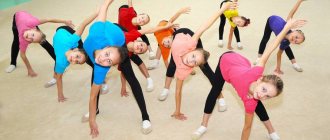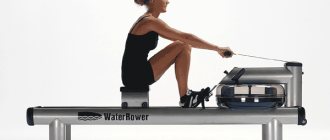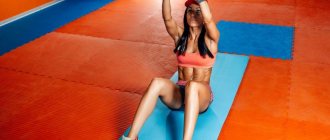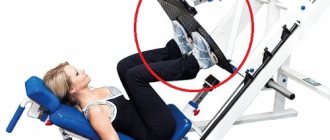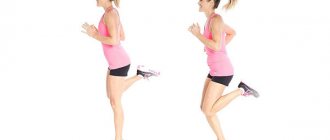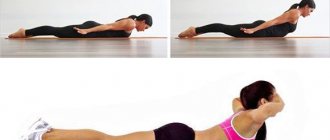Leg raises on parallel bars cannot be called a simple exercise; it involves not only the abdominal muscles, but also involves grouping the stabilizer muscles to keep the body in an upright position. Its simplified version is a lying leg raise while lying on the floor, and a more complicated version is a hanging leg raise. Both options are aimed at developing the press, but let's focus on the parallel bars technique and get acquainted with the main advantages and disadvantages of this exercise.
Advantages and disadvantages of standing leg raises
Let's start with the advantages:
- Uniform load on muscles. The parallel bars, or rather the vertical position of the body, allows you to work the rectus abdominis muscle, involving in the work the lower part of the rectus muscle, which is least involved in straight crunches on the floor.
- Burns more calories. Compared to exercises on the floor, lifting on parallel bars is a more energy-consuming exercise, as it requires additional fixation of the body in the simulator, due to which the muscles of the shoulder girdle are involved in the static load.
- The presence of a support allows you to eliminate body swaying, for example, as when hanging on a bar, which makes the exercise technique clearer and more concentrated.
Disadvantages of the exercise:
- Quite a difficult exercise that requires good position stabilization . When the elbows and lower back are supported, the load on the shoulder girdle is not reduced. If the shoulder and chest muscles are untrained, there is a high probability that the neck will sag under the shoulders, which will additionally overload the trapezius muscle and the sternocleidomastoid muscle of the neck, which will also make breathing difficult.
- Weak abdominal muscles will also not cope with the load , despite the fact that the exercise is intended to strengthen them. In addition to dynamic lifts, the abdominal muscles are also responsible for stabilizing the body in the machine, controlling the fit of the lower back to the back of the machine and are in constant tension, which cannot be interrupted during the approach. Let's return to this point in technology. Therefore, you should start doing leg raises on the uneven bars only after mastering the option lying on the floor.
Rating of abdominal exercises: scientific data
Which works better: leg raises, ab rollers, or regular crunches?
Best Ab Exercise - Research
A scientific study conducted at the University of San Diego assessed the effectiveness of the most popular abdominal exercises (and machines)(1). The participants in the experiment were volunteers, 30 absolutely healthy men and women aged 20-45 years.
Using the electromyography method and special equipment, the load in the upper, lower and oblique (lateral) abdominal muscles was measured. The degree of involvement of the muscles of the front surface of the thighs was also measured to determine whether the exercise was performed correctly or incorrectly.
Performing abdominal exercises that involve the pelvic rotators and hip muscles can harm your posture.
Press: rating of the best exercises
The result of the exercise was compared with classic abdominal crunches. If the exercise factor is, for example, 200, this means that the exercise engages the abdominal muscles twice as effectively as crunches. If it’s 25, then it’s four times worse.
Rectus abdominis muscle
- Exercise “Bicycle” 248
- Hanging Leg Raises 212
- Crunches on a fit ball 139
- Crunches with legs up 129
- Ab roller crunches 127
- Crunches with arms extended behind the head 119
- Reverse crunches 109
- Ab Roller 105 crunches
- Elbow stand (“plank”) 100
- Ab Rocker 21 ab trainer
Lateral abdominal muscles
- Hanging Leg Raises 310
- Exercise “Bicycle” 290
- Reverse crunches 240
- Elbow stand (“plank”) 230
- Crunches with legs up 216
- Crunches on a fit ball 147
- Roller crunches 145
- Crunches with arms outstretched 118
- Ab Roller 101
- Ab Rocker 74 Abs Trainer
7 Best Abdominal Exercises
Exercise "Bicycle".
Starting position: lying on your back, lower back pressed to the floor. Raise your upper torso, then your legs; begin to alternately pull your knees towards your head. The right knee should touch the left elbow, then vice versa.
Leg raises. The exercise is performed both with and without fixing the back in the machine (hanging leg raises). During execution, the body remains motionless, only the legs bent at the knees move. It is important to feel the work of the abdominal muscles and constantly monitor the movement.
Roller crunches. The exercise can be performed not only with a special roller, but also with dumbbells or a barbell rolling on the floor. Get on your knees, transfer your body weight to your hands, “roll” forward, then, using the strength of your abdominal muscles, return to the starting position.
Crunches on a fit ball. Sit on a fit ball, place your hands behind your head, then lean back. Using a controlled movement using your abdominal muscles, lift your body, hold for a second and lower yourself down again. Your thighs should remain parallel to the floor when performing.
Crunches with legs raised up. Lying on your back, your lower back pressed tightly to the floor, your arms along your body. Raise your legs up, knees slightly bent, ankles touching each other. Using the strength of your abdominal muscles, slowly lift your pelvis, as if twisting towards your head.
Exercise "Plank". This exercise is considered the best static exercise for the abdominal muscles. It is necessary to take a stable position on your elbows, fix your body, tighten your abdominal muscles - and maintain this position for 30-40 seconds. Then repeat several times.
Crunches with arms outstretched. The exercise is in many ways similar to classic crunches, however, when performing it, the arms are not placed behind the head, but extended back. Actually, this is what makes the exercise more difficult, increasing the level of muscle involvement in the work.
Are the upper and lower abs separated?
The study found that most subjects were unable to differentiate between upper and lower abdominal muscle involvement during exercise. The movements, in fact, were performed due to the participation of all parts of the abdominal muscles at the same time.
However, this does not mean that it is impossible to specifically load the lower abdomen. This just goes to show that the average exerciser is unable to concentrate on engaging the various sections of the abs. Working out the lower abs requires a special technique.
Does the ab roller work?
Another myth debunked by this study is the super-effectiveness of the abdominal roller or other special exercise equipment. Yes, exercises with a roller show slightly greater results than regular crunches, but there are also more effective exercises.
A common criticism of the research was that different people performed abdominal exercises differently and used the muscles differently, even under the guidance of the same trainer. This suggests that there is a best abdominal exercise for each person.
The results of a scientific study showed that the most effective exercises for the abdominal muscles are hanging leg raises, bicycle movements and crunches with raised legs. However, the execution technique can significantly change the final result of muscle involvement.
Source
What muscles work when lifting legs on parallel bars?
Main muscles:
- Rectus abdominis muscle.
- External oblique abdominal muscles.
- The rectus femoris and iliopsoas muscles are involved in bringing the legs toward the body.
Muscles involved in position stabilization:
- Sternocleidomastoid muscle.
- Deltoid.
- Pectoralis major muscle.
- Biceps brachii muscle.
- Triceps brachii muscle.
How to pump up your abs on parallel bars
With effective exercises on this apparatus, you can work on the strength and definition of your abdominal muscles. This is especially true for its lower part - after all, it is the most difficult in terms of pumping.
Remember that you need to work on your arm strength first. Without a strong stance, technically correct execution is impossible.
If you feel pain in your shoulders, elbows or wrists during parallel bars, you should be careful.
The cause may be joint diseases, and excessive stress can aggravate the situation. Video of pumping up the press on uneven bars
Straight leg raise technique in the simulator
- Stand on the special leg bars to get into the correct starting position.
- Place your forearms on the special supports and grab the hand grips.
- Press your spine against the back of the machine. Be especially careful that your lower back does not come off the machine. To do this, you need to tense the rectus abdominis muscle and not relax during the approach.
- Lower your legs straight down, keeping them together.
- Exhale and raise your legs until they are parallel to the floor without bending your knees. Work exclusively with your abdominal muscles, do not compensate for the load with the shoulder girdle.
- Keep your neck extended, do not “hide” your head under your shoulders.
- As you inhale, slowly lower your legs down, but do not lift your lower back from the machine. At the lowest point, do not relax your abs.
Execution technique
Initial position:
- Grasp the handles with your hands,
- Stand on your elbows, placing your forearms on the pads of your handles.
- Lean your back completely against the support of the machine.
- Keep your legs hanging in front of you.
Movement:
- Inhale and, holding your breath, powerfully lift your straight legs up (maintain a slight angle at the knees) and at the same time lift your pelvis.
- Exhale and pause for 1-2 seconds at the top of the movement.
- Slowly and under control, lower your legs down to the starting position.
- Without relaxing your abdominal muscles, move on to the next repetition.
- Complete the planned amount of work and complete the approach.
Attention!
- Avoid swinging your legs, consciously or unconsciously. Of course, in this case the lifting will be easier, but the load on the abdominal muscles will be proportionally reduced.
- Keep your knees at a small, fixed angle for the rest of the set to better isolate your abdominal muscles and prevent the load from shifting to your back.
- Do not lower your legs down to a vertical position to keep your muscles constantly tense.
- Do not “fall” down when returning to the starting position. This contributes to the “premature” shutdown of the abdominal muscles, that is, they do not receive the full load assigned to them.
Recommendations!
- Try to lift your pelvis towards your sternum, lifting it away from the support of the machine. Only in this case is maximum contraction of the abdominal muscles possible.
- Perform leg raises above the horizontal, which will put more stress on the abdominal muscles.
- Don't relax your abs between reps to increase the intensity of your workout.
- Rigidly fix the shoulder girdle when taking the starting position to prevent injury to the shoulder joint.
- Pull the sock towards you to better concentrate on the moment of “twisting”.
Execution options!
We recommend reading: How to pump up the lower part of the pectoral muscles
| Raising the knees while resting on the elbows. According to the main points of the technique, the exercise repeats the mechanics of the basic movement - the legs bent at the knees should be “pulled” to the chest, pushing the pelvis up. However, the load on the press in this version of the lifts will be significantly reduced due to the reduction in the length of the “counterweight”. The variation is often used by athletes with low physical fitness. |
| Lateral leg raises in support. You can shift the emphasis of the load to the oblique abdominal muscles by turning your legs slightly to the side. |
| Leg raises supported by parallel bars. In this case, the emphasis is on the hands. It is important to keep your body upright during lifts and not lean forward. The version of leg raises on parallel bars is more difficult, since in this case there is no back support and the athlete needs to make additional effort to stabilize the body. Plus, the arm muscles themselves must have sufficient strength, which actually takes on the weight of the athlete’s body. |
Raising bent legs in support on parallel bars
Despite the fact that this is a simpler option, since the load on the rectus abdominis muscle is reduced by bending the legs, it also has its own technical nuances and features.
- The starting position is completely repeated.
- Straight legs below are together.
- Next, exhale, lift your legs up, bending your knees to a right angle, bring them to your chest, but do not tear your lower back from the back.
- That is, in the upper position of the knees, the back remains completely pressed against the machine, despite the design of the machine - vertical or inclined.
- As you inhale, slowly lower your knees, gradually straightening them, but, be careful , do not fully straighten them at the lowest point, maintaining tension in your abdominal muscles and the position of your lower back. Thus, the legs should not be strictly vertical with the body.
#2 Don't throw your feet down
Many people throw their legs down during the negative phase of the movement. This technique leads to two consequences at once:
- The abdominals stop working in the negative phase of the movement, that is, they start working only halfway through the exercise.
- The body may begin to sway. In this case, due to inertia, your abdominal muscles will be less involved in the work even when lifting your legs.
Solution: Return your legs to the bottom position slowly and in a controlled manner. Try to feel your abdominal muscles during the negative phase of the movement. At the lowest point, the abdominal muscles should remain tense.
Recommendations for implementing leg raises in the abdominal machine
Start mastering the exercise in the range of 15-20 repetitions for 3 sets. If it turns out less, it’s not scary. The main thing is to do it right. As soon as the neck and chest begin to sag, although there is still enough strength in the abdominal muscles, complete the approach. Then it is better to do the exercise while lying down.
For those who find it easy to perform more than 25-30 repetitions, it is recommended to use weighted leg cuffs or hold a medicine ball with your feet. Thus, the number of repetitions can be reduced to 15 and performed in 3-4 sets. The main thing is to feel a burning sensation in the abdominal muscles by the end of the approach.
Abdominal training on the horizontal bar and parallel bars
For more effective results, you can combine exercises on the horizontal bar, parallel bars and on the ground. As one option, you can use a program of 4 exercises:
- Walk on bars, 3 x max
- Roman chair on parallel bars, 3 x 20
- Hanging leg raises, 3 x 20
- Scissors on the crossbar, 3 x 20
- Corner on the horizontal bar, 3 x max
All exercises are performed based on physical capabilities. At the initial stage, you can take 3 sets of 10-15 repetitions.
Features of correct exercise execution
The technically correct execution of leg lifts with emphasis on the elbows is done like this. Initially, you need to take the starting position: stand on the supports and hold tightly to the handles of the simulator. The legs below are pressed together and slightly bent at the knees. The neck is straight, the back is tightly pressed to the support. We inhale and, as we exhale, raise our legs to a horizontal level or slightly higher, depending on your physical fitness. It is best to raise your knees while touching your body. In a tense state, we linger for a few seconds and calmly lower our legs while inhaling.
Carefully read useful tips from experienced trainers:
- When lifting your limbs while resting on your elbows, do not swing your torso and do not push your legs back too far.
- The exercise will be more effective if you raise your legs higher and at the same time twist your pelvis.
- To make the exercise easier, it is better to bend your knees.
- To disengage your back muscles (especially when there are problems), do not do lifts with straight legs.
Typical mistakes that beginners often make are moving their legs too far back and throwing them up in the form of a pendulum. In this case, the press does not work at full strength, and the exercise is performed due to inertial movement.
We present to your attention an example of performing leg raises on uneven bars. Be sure to watch this video clip.



